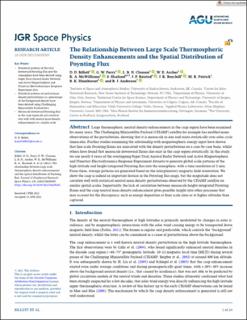| dc.contributor.author | Billett, Daniel | |
| dc.contributor.author | Clausen, Lasse Boy Novock | |
| dc.contributor.author | Archer, William | |
| dc.contributor.author | McWilliams, Kathryn A. | |
| dc.contributor.author | Håland, Stein Egil | |
| dc.contributor.author | Reistad, Jone Peter | |
| dc.contributor.author | Burchill, J. K. | |
| dc.contributor.author | Patrick, M. R. | |
| dc.contributor.author | Humberset, Beate Krøvel | |
| dc.contributor.author | Anderson, B. J. | |
| dc.contributor.author | Perry, G. W. | |
| dc.date.accessioned | 2021-08-10T08:44:34Z | |
| dc.date.available | 2021-08-10T08:44:34Z | |
| dc.date.created | 2021-05-04T10:53:54Z | |
| dc.date.issued | 2021 | |
| dc.identifier.issn | 2169-9380 | |
| dc.identifier.uri | https://hdl.handle.net/11250/2767127 | |
| dc.description.abstract | Large thermospheric neutral density enhancements in the cusp region have been examined for many years. The Challenging Minisatellite Payload (CHAMP) satellite for example has enabled many observations of the perturbation, showing that it is mesoscale in size and exists statistically over solar cycle timescales. Further studies examining the relationship with magnetospheric energy input have shown that fine-scale Poynting fluxes are associated with the density perturbations on a case-by-case basis, whilst others have found that mesoscale downward fluxes also exist in the cusp region statistically. In this study, we use nearly 8 years of the overlapping Super Dual Auroral Radar Network and Active Magnetosphere and Planetary Electrodynamics Response Experiment datasets to generate global-scale patterns of the high-latitude and height-integrated Poynting flux into the ionosphere, with a time resolution of 2 min. From these, average patterns are generated based on the interplanetary magnetic field orientation. We show the cusp is indeed an important feature in the Poynting flux maps, but the magnitude does not correlate well with statistical neutral mass density perturbations observed by the CHAMP satellite on similar spatial scales. Importantly, the lack of correlation between mesoscale height-integrated Poynting fluxes and the cusp neutral mass density enhancement gives possible insight into other processes that may account for the discrepancy, such as energy deposition at finer scale sizes or at higher altitudes than captured. | en_US |
| dc.language.iso | eng | en_US |
| dc.publisher | Wiley | en_US |
| dc.rights | Navngivelse-Ikkekommersiell 4.0 Internasjonal | * |
| dc.rights.uri | http://creativecommons.org/licenses/by-nc/4.0/deed.no | * |
| dc.title | The Relationship Between Large Scale Thermospheric Density Enhancements and the Spatial Distribution of Poynting Flux | en_US |
| dc.type | Journal article | en_US |
| dc.type | Peer reviewed | en_US |
| dc.description.version | publishedVersion | en_US |
| dc.rights.holder | Copyright 2021. The Authors | en_US |
| dc.source.articlenumber | e2021JA029205 | en_US |
| cristin.ispublished | true | |
| cristin.fulltext | original | |
| cristin.qualitycode | 2 | |
| dc.identifier.doi | 10.1029/2021JA029205 | |
| dc.identifier.cristin | 1907931 | |
| dc.source.journal | Journal of Geophysical Research (JGR): Space Physics | en_US |
| dc.identifier.citation | Journal of Geophysical Research: Space Physics. 2021, 126 (5), e2021JA029205. | en_US |
| dc.source.volume | 126 | en_US |
| dc.source.issue | 5 | en_US |

